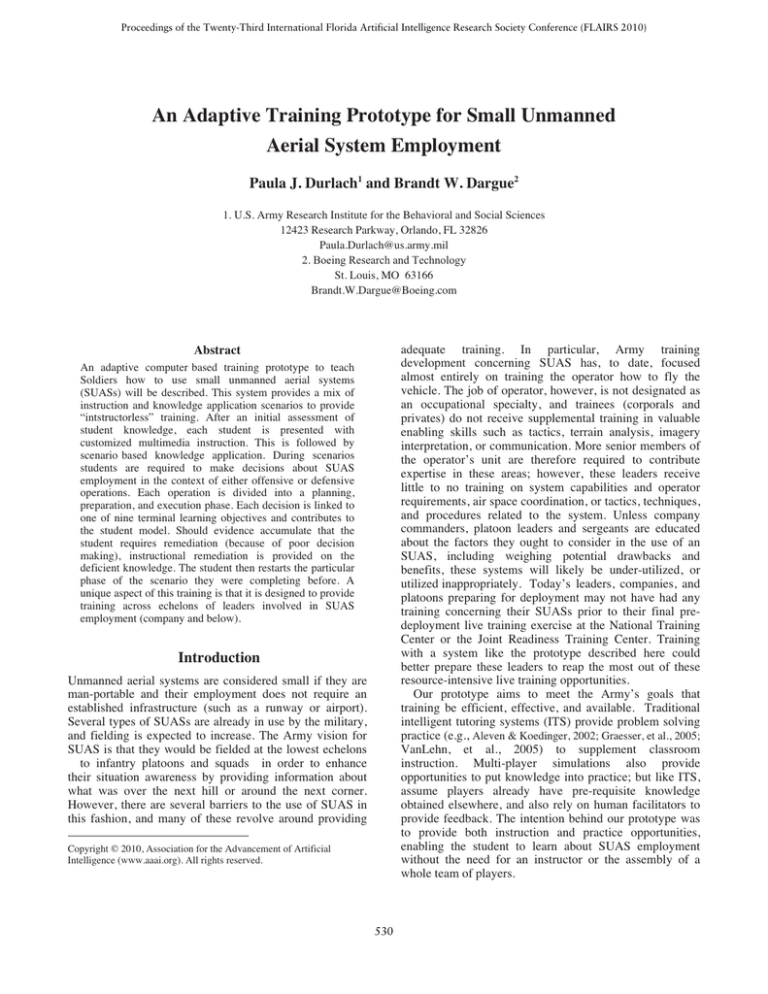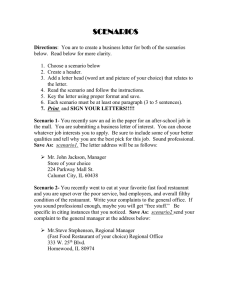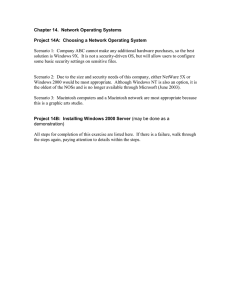
Proceedings of the Twenty-Third International Florida Artificial Intelligence Research Society Conference (FLAIRS 2010)
An Adaptive Training Prototype for Small Unmanned
Aerial System Employment
Paula J. Durlach1 and Brandt W. Dargue2
1. U.S. Army Research Institute for the Behavioral and Social Sciences
12423 Research Parkway, Orlando, FL 32826
Paula.Durlach@us.army.mil
2. Boeing Research and Technology
St. Louis, MO 63166
Brandt.W.Dargue@Boeing.com
adequate training. In particular, Army training
development concerning SUAS has, to date, focused
almost entirely on training the operator how to fly the
vehicle. The job of operator, however, is not designated as
an occupational specialty, and trainees (corporals and
privates) do not receive supplemental training in valuable
enabling skills such as tactics, terrain analysis, imagery
interpretation, or communication. More senior members of
the operator’s unit are therefore required to contribute
expertise in these areas; however, these leaders receive
little to no training on system capabilities and operator
requirements, air space coordination, or tactics, techniques,
and procedures related to the system. Unless company
commanders, platoon leaders and sergeants are educated
about the factors they ought to consider in the use of an
SUAS, including weighing potential drawbacks and
benefits, these systems will likely be under-utilized, or
utilized inappropriately. Today’s leaders, companies, and
platoons preparing for deployment may not have had any
training concerning their SUASs prior to their final predeployment live training exercise at the National Training
Center or the Joint Readiness Training Center. Training
with a system like the prototype described here could
better prepare these leaders to reap the most out of these
resource-intensive live training opportunities.
Our prototype aims to meet the Army’s goals that
training be efficient, effective, and available. Traditional
intelligent tutoring systems (ITS) provide problem solving
practice (e.g., Aleven & Koedinger, 2002; Graesser, et al., 2005;
VanLehn, et al., 2005) to supplement classroom
instruction. Multi-player simulations also provide
opportunities to put knowledge into practice; but like ITS,
assume players already have pre-requisite knowledge
obtained elsewhere, and also rely on human facilitators to
provide feedback. The intention behind our prototype was
to provide both instruction and practice opportunities,
enabling the student to learn about SUAS employment
without the need for an instructor or the assembly of a
whole team of players.
Abstract
An adaptive computer based training prototype to teach
Soldiers how to use small unmanned aerial systems
(SUASs) will be described. This system provides a mix of
instruction and knowledge application scenarios to provide
“intstructorless” training. After an initial assessment of
student knowledge, each student is presented with
customized multimedia instruction. This is followed by
scenario based knowledge application. During scenarios
students are required to make decisions about SUAS
employment in the context of either offensive or defensive
operations. Each operation is divided into a planning,
preparation, and execution phase. Each decision is linked to
one of nine terminal learning objectives and contributes to
the student model. Should evidence accumulate that the
student requires remediation (because of poor decision
making), instructional remediation is provided on the
deficient knowledge. The student then restarts the particular
phase of the scenario they were completing before. A
unique aspect of this training is that it is designed to provide
training across echelons of leaders involved in SUAS
employment (company and below).
Introduction
Unmanned aerial systems are considered small if they are
man-portable and their employment does not require an
established infrastructure (such as a runway or airport).
Several types of SUASs are already in use by the military,
and fielding is expected to increase. The Army vision for
SUAS is that they would be fielded at the lowest echelons
to infantry platoons and squads in order to enhance
their situation awareness by providing information about
what was over the next hill or around the next corner.
However, there are several barriers to the use of SUAS in
this fashion, and many of these revolve around providing
Copyright © 2010, Association for the Advancement of Artificial
Intelligence (www.aaai.org). All rights reserved.
530
decisions regarding SUAS employment. This is up to the
discretion of the leader to whom the SUAS is assigned. He
may decide to be involved in the employment of the SUAS
himself, or completely delegate its employment to a lower
echelon.
The training is adaptive in two main ways. First, a
pretest determines which learning objectives (if any)
require instruction for each individual, prior to their
entering the scenario context. This adaptation is intended
to deal with the varied prior experience of the potential
training audience (e.g., previous deployment history or
not). Second, performance during each scenario is used to
determine what (if any) remediating instruction the learner
requires. Mastery is required as demonstrated in scenario
completion; and, instructional time is tailored to achieve
this.
The Student Experience
At the beginning of training, the student will take a brief
pre-test, sampling knowledge of the learning objectives.
On the basis of the test results, relevant instructional
materials will be selected by the system for the student to
review. A student showing proficiency can be routed
directly to a scenario. A student requiring instruction on a
limited set of learning objectives will receive that
instruction and then go on to the scenario. A student
showing little to no proficiency will received instruction
and scenarios by phase (e.g., the planning phase instruction
and then planning phase scenario). The intention here is to
avoid a lengthy period of instruction without opportunity to
apply the knowledge.
Once the student begins a scenario, the following rules
apply. As mentioned before, each decision point consists of
situational background followed by a decision, with four
possible choices. A hint button is available, and hints are
provided at three levels of specificity. The first level is
fairly general. Asking for the first hint does not affect the
student model. Asking for the second level hint degrades
the learning objective score by half a point, and asking for
the third level hint degrades the learning objective score by
a full point. Acceptable decisions lead the student to the
next node in the decision tree. Unacceptable decisions
affect the student model on a terminal learning objective
basis. If the total “strikes” for a terminal learning objective
reaches three, the scenario is aborted and the student is
given
relevant
remedial
instruction.
Following
remediation, the student restarts the scenario phase they
were in before (planning, preparation, or execution).These
parameters for transitioning from scenario to remediation
were based on intuition. They can be altered based on
student testing or absolute standards required by the work
place, in this case, the Army. Scenarios end with a review
of performance.
Learning Objectives
Nine terminal learning objectives were selected based on
the scope of our project and analysis of the knowledge
leaders need to bring to bear on SUASs operations. Each
terminal learning objective had three to 10 associated
enabling learning objectives, for a total of 48 enabling
objectives. For example for Airspace mission requests,
there were three types of requests to be covered: planned,
immediate, and dynamic. Didactic materials to teach
knowledge of the enabling objectives were constructed by
selecting information from relevant doctrine and other
Army publications. Subject matter experts then constructed
scenarios which would allow students to demonstrate
knowledge of the learning objectives in the context of
tactical missions.
Scenario Structure
Each scenario consists of three phases: planning,
preparation, and execution. Each phase consists of three to
four decisions points, and each decision point is linked to
one or more learning objectives. At each decision point,
the student is offered an update of the situation and must
decide among one of four possible choices. A challenge of
this domain is that the correctness of decisions may be
debated. “Doctrine,” as written in a field manual, is not
necessarily the best practice compared to that which has
evolved as a result of real-world experience. We therefore
decided to include at each choice point: the doctrinal
solution, two non-doctrinal, but viable solutions, and one
very poor (unacceptable) solution. Each decision is
followed by feedback, and then, depending on which
decision was selected, the scenario branches to one of three
alternate updated situations. In the case of an unacceptable
choice, the student is directed to choose again.
A novel aspect of these scenarios is that the student’s
role may change in the scenario from one decision point to
another. For example, at one point in the mission the
student may be a company commander, whereas in
another, they may be a squad leader. This provides the
student with an overall picture of the decisions that must be
made to employ the SUAS, regardless of their specific
position. It also copes with the fact that there is no
standardized cross-unit assignment of who makes what
References
Aleven, V. and Koedinger, K. R. 2002. An effective meta
cognitive strategy: learning by doing and explaining with a
computer based Cognitive Tutor. Cognitive Science. 26: 147 179.
Graesser, A. C.; Chipman, P.; Haynes, B. C.; and Olney, A.
2005. AutoTutor: An intelligent tutoring system with mixed
initiative dialogue. IEEE Transactions in Education. 48: 612
618.
VanLehn, K.; Lynch, C.; Schulze, K. Shapiro; J. A.,
Shelby; R., Taylor, L.; Treacy, D.; Weinstein, A.; and
Wintersgill, M. 2005. The Andes physics tutoring system:
Lessons Learned. International Journal of Artificial
Intelligence and Education. 15: 1-47.
531



